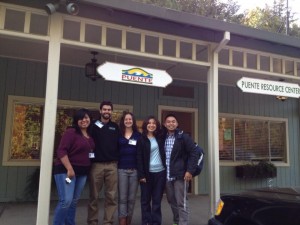Sometimes an anniversary is an occasion to look back and salute the past. Puente staffers are far too busy planning for the future to spend much time reminiscing. So rather than rest on our laurels, Puente used the occasion of its 15th anniversary (1998-2013) to launch some major new projects and initiatives. They range from successfully advocating for county funding for a new mobile health clinic, to getting high school students enrolled in Stanford academic programs for the first time.
Check out our Facebook photo stream by clicking here.
Funding for new mobile health clinic
Locals waved goodbye to their only convenient source of regular, preventive health care when San Mateo County cut funding for its mobile health clinic in 2009. With the nearest doctor’s office dozens of miles away, Puente’s staff resolved to restore funding for a new mobile health van – one that could serve the South Coast exclusively.
This fall, their advocacy work paid off. The San Mateo County Board of Supervisors officially set aside funding for the new mobile health clinic, which will arrive in late 2014. A doctor, a nurse and a community outreach worker will staff the clinic. The initial funding for the clinic – a $1 million, two-year grant – comes from Measure A, a half-cent sales tax approved by San Mateo County voters in 2012.
“It’s a doctor on wheels. It’s expected that people will go for every aspect of heath care problems, like asthma and hypertension and diabetes,” says Puente Executive Director Kerry Lobel.
San Mateo County Supervisor Don Horsley was steadfast in his support of Puente’s vision for a community health solution on the South Coast and provided a big dose of leadership on behalf of the project. Puente has joined forces with Stanford Professor Dr. Gabe Garcia, who will train Stanford University physicians to help staff the mobile health van and boost South Coast preventive efforts.
Puente will also train health promoters who will personally visit the poorest and most isolated residents, get them signed up for government-sponsored health care, and make sure they visit the medical van.

Making education bilingual, for students, parents and teachers
A whopping 48.7 percent of students in the La Honda-Pescadero Unified School District are designated as English Learners. Not having sufficient English skills can make learning extremely difficult. But too often, students’ Spanish-speaking roots are perceived as a liability, rather than the 21st C asset that they really are.
This year, Puente and the school district honored students who have excellent command of both English and Spanish with the State of California’s Seal of Biliteracy, a distinction that marks them as stewards of an increasingly diverse, multicultural future America.
Puente’s Academic Director, Suzanne Abel, approached the school district with information about the Seal of Biliteracy after she learned of it last year. It is her hope that it will become a point of pride for the students as well as a resume-builder.
“It will underscore to bilingual kids that they have a set of skills worth honing that normally aren’t recognized,” Abel says.
In May, three Pescadero High School graduates were the first to receive their Seals of Biliteracy. It’s a great resume-builder in a job market hungry for bilingual workers, and a way to let their backgrounds shine instead of downplaying them.
Many bilingual students have served as de facto interpreters during parent-teacher meetings. It’s not unusual for a student’s parents to speak only Spanish, Spanish, while a teacher may not speak Spanish at all. The tension inherent in this situation was obvious to Abel, whose conversations with Stanford Professor Guadalupe Valdés around issues related to language included exploration of educational interpreting as a new field of research and practice. Valdés will teach a practicum in educational interpreting spring quarter at Stanford. In anticipation of that course, Stanford graduate intern Eduardo Muñoz Muñoz took the lead in recruiting bilingual interpreters from a pool of contacts at Stanford University for the high school and middle school, while Puente board member Larry Trujillo recruited from his class at San Francisco State University for the elementary school. Nearly 200 conferences were interpreted by 13 Stanford interpreters, while 40 families were served by four SFSU interpreters. Parents and teachers alike were pleased with the effort, and students were absolved of the awkwardness of translating between parents and teachers about their own academic performance. Perhaps most importantly, parents not only came away with a better understanding of their children’s schoolwork, but learned about how they could help with homework and other projects.
Stanford connections spur Pescadero students on to big dreams
What’s it like to spend a year on one of the most beautiful and exciting university campuses in the country? This year, ten highly motivated students from Pescadero and La Honda got to find out.
The students are enrolled in the Stanford Ambassadors Gateway Exchange Program (SAAGE), a university-community partnership that brings local students from Pescadero and East Palo Alto to Stanford’s Center for Latin American Studies (CLAS) for twelve 3-hour classes over the course of a year. They hear from Stanford faculty and visiting scholars from Latin America, studying all aspects of Latin America – history, literature, politics and ecology – for credit. Students are bussed in every few weeks, dinner is provided, and classes are free, courtesy of a federal Title VI National Resource Center grant to Stanford that prioritizes K-14 outreach.
SAAGE is one facet of a multidisciplinary partnership with Stanford that gives students from an isolated, rural community an exciting academic challenge. Most of all, it helps them see themselves on the campus of a four-year college when they graduate from high school.

It’s hard to imagine what it’s like to be in college unless you’re there,” says Suzanne Abel, Academic Director for Puente. “Being at Stanford, learning directly from professors in several fields, our students can open a personal door to the very real possibility of college.”
Puente also helped connect one particularly gifted local student with Stanford’s RISE (Raising Interest in Science and Engineering) Internship Program, which took place last summer. This rigorous program essentially acts as a part-time job, involving 30 hours per week of lab work with an academic mentor, plus field trips, presentations, and other activities.
The program enrolls low-income high school students who show promise in science and engineering, and who will be the first in their families to go to college. There is a $2,500 stipend. Most students who graduate from RISE, which was founded in 2006, do enroll in college and pursue a science, engineering or math-related major.
Puente spots gaps in health care with community-wide survey
With all the health care changes out of Washington, and a new mobile health clinic coming to the South Coast next year, Puente undertook an unprecedented community health care survey in late 2013. From a data standpoint, so little is known about the particulars of people’s lives on the South Coast, including basic demographic information. In addition to acting as census takers, Puente’s volunteers wanted to know: who has health insurance? And who has access to a doctor?
“People who didn’t have insurance before are now going to be required to get it. And we will be on the forefront of connecting people to these new services,” says Puente Community Outreach Coordinator Ben Ranz.

With roughly 5,000 residents spread out over the South Coast – 40 percent of the county’s overall landmass – the survey effort has been extensive. Volunteers are gathering information on people’s current health care access; informing them about Puente’s own health care services; and helping them meet the requirements contained in the Affordable Care Act, which have become a lot more confusing in recent weeks.
Survey results will be available in January. Puente intends to share the data with county health officials, and use it to help guide the doctors and nurses who will be staffing the new mobile health clinic, by directing them to the parts of the region that need them the most.
Puente also recently held two workshops about Covered California (the state version of the Affordable Care Act) specifically for an audience of male and female farm, ranch and nursery workers.
